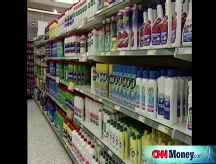Oil prices ease; gas still at record high
Oil prices slip on a big growth in the stockpile of gas last week and global demand concerns.
NEW YORK (CNNMoney.com) -- Oil prices dipped below $122 Wednesday, pushed down by a government report that said supplies of gasoline increased much more than expected last week. But industry experts are mixed as to how long it will be until consumers feel any relief at the pump.
U.S. light crude for July delivery fell $2.01 to settle at $122.30 a barrel on the New York Mercantile Exchange, its lowest close since May 6. Earlier in the day, prices fell as low as $121.84.
In its weekly inventory report, the U.S. Energy Information Administration said crude supplies fell by 4.8 million barrels last week.
That potentially points to higher oil prices, but analysts said the price of oil declined because of the increase in gas supplies, which rose by 2.9 million barrels, far above the 900,000 barrels anticipated by economists.
Supplies of distillates, used to make heating oil and diesel fuel, increased by 2.3 million barrels.
Even as crude oil prices have come off their highs, however, retail gas prices have continued to march to record highs during this summer driving season.
The national average price for a gallon of regular unleaded gasoline rose to a record high of $3.983, according to AAA's Web site on Wednesday. That is the 27th record high in 28 days.
"Even if we do see some relief in crude oil prices, that may not be transferred immediately into relief at the pump," said Amanda Kurzendoerfer, a commodity analyst at Summit Energy.
Andrew Lebow, a broker at MF Global, however, said drivers might get some relief. "I think pump prices are going to go down in the very near term," he said. As refineries increase production and consumers look to conserve their driving this summer, consumers could see a nickel or dime shaved off the price at the pump, according to Lebow.
The average price for gas has passed the $4 a gallon mark in 13 states, as well as in Washington, D.C, according to AAA's Web site.
As a result of $4 gas pressures, car manufacturer General Motors (GM, Fortune 500) announced yesterday that it would be closing four plants that make gas-guzzling trucks and SUVs. GM also announced it would be upping production of more fuel efficient cars.
At 306.8 million barrels, U.S. crude oil inventories are in the lower half of the average range for this time of year.
But one promising sign for strapped motorists: the report showed refineries operated at 89.7% of capacity last week, up from 87.9% the week before and well above the 88.5% level analysts were expecting. The capacity is just below the usual 90% rate for this time of year.
With crude supplies much lower than expected, the price of crude futures would typically shoot up, said Lebow. "The focus is on the gas demand being so weak," he said.
According to the government report, over the past four weeks, motor gasoline demand has averaged 9.3 million barrels per day, down by 1.4% from the same period last year.
Light sweet crude settled at $124.31 on Tuesday, which was down $3.45 from Monday's settlement. Tuesday marked oil's lowest settlement price on Nymex since May 15. Oil prices hit a record intraday high of $135.09 a barrel on May 22.
Rapid demand growth in emerging countries pushed the price of crude up to $135. As developing countries raise their government fuel subsidies, making fuel more expensive to consumers in those countries, demand will lessen, said Kurzendoerfer.
India just lifted its subsidy Wednesday, and Malaysia said it will raise gasoline prices.
It will take awhile for a change in demand to register, but "the market is all about future expectations and so the idea that the market could be turning definitely has an impact," said Kurzendoerfer. ![]()



